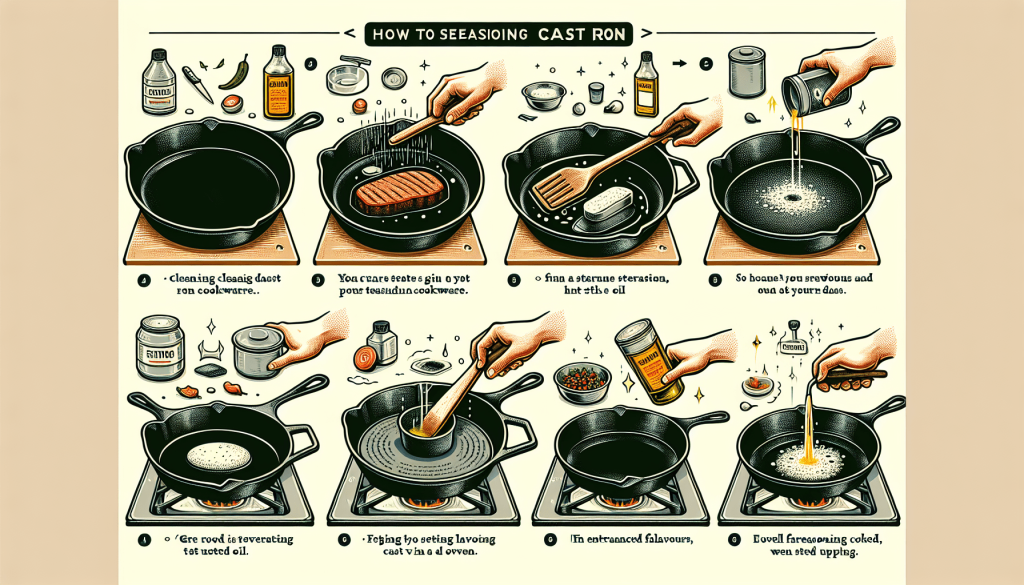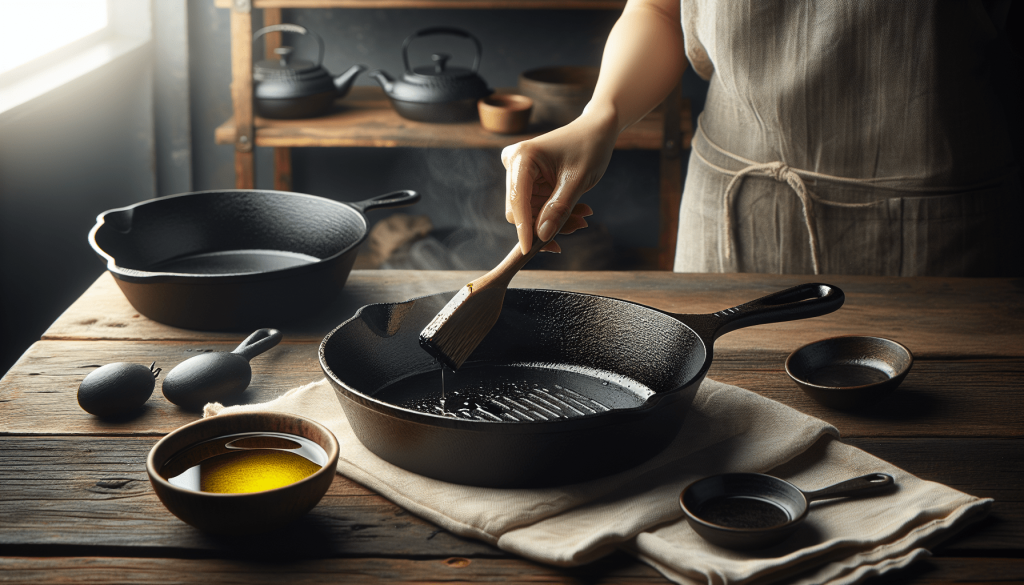So you’ve got yourself a shiny new piece of cast iron cookware, and now you’re wondering how to give it that perfect seasoning? Look no further! In this article, we’ll explore the best method for seasoning your cast iron cookware to ensure it stays non-stick, rust-free, and ready to whip up delicious meals for years to come. Whether you’re a seasoned chef or a novice in the kitchen, we’ve got you covered with expert tips and tricks that will have your cast iron cookware performing at its best. Get ready to unlock the secrets to perfectly seasoned cast iron!

What is seasoning?
Definition
Seasoning refers to the process of treating cast iron cookware with a layer of oil or fat and heating it to create a protective coating. This coating not only helps prevent rust but also enhances the non-stick properties of the cookware.
Purpose
The purpose of seasoning cast iron cookware is to create a natural non-stick surface, improve heat retention and distribution, prevent rusting, and enhance the overall longevity of the cookware. When done correctly, seasoning can turn a regular cast iron pan into a reliable tool that will last for generations.
Preparing the cast iron
Cleaning the cookware
Before seasoning your cast iron cookware, it is crucial to start with a clean surface. Use warm water and a mild dish soap to remove any food residues or debris. Avoid using harsh abrasives or scrub brushes that can damage the surface of the cookware.
Drying the cookware
After cleaning, thoroughly dry your cast iron cookware with a towel. Any remaining moisture can hinder the seasoning process and potentially lead to rust formation. Ensure the cookware is completely dry before proceeding to the next step.
Removing rust
If your cast iron cookware has developed rust, it is essential to address it before seasoning. Scrub the rusted areas with a steel wool pad or a mixture of baking soda and water to gently remove the rust. Rinse and dry the cookware before moving on to the seasoning process.
Choosing the seasoning oil
Best oils for seasoning
When it comes to choosing the right oil for seasoning your cast iron cookware, oils with high smoke points are recommended. Some excellent options include canola oil, vegetable oil, flaxseed oil, and grapeseed oil. These oils can withstand high temperatures without burning or turning rancid, resulting in a durable and effective seasoning.
Considerations for oil choice
Apart from the smoke point, other factors to consider when choosing a seasoning oil are availability and cost. You want an oil that is easily accessible and doesn’t break the bank. Additionally, some oils may develop a sticky residue during the seasoning process, so it’s wise to opt for oils that have little to no chance of creating this sticky residue.
Applying the seasoning
Coating the cookware
To apply the seasoning, pour a small amount of your chosen oil onto the cast iron cookware’s surface. Use a clean cloth or paper towel to spread the oil, ensuring an even coating on all surfaces, including the handle and exterior. Be mindful not to use too much oil, as an excessive amount can result in a sticky or tacky layer.
Baking the cookware
After coating the cookware, place it upside down on the middle rack of a preheated oven. The oven should be set at a temperature of around 350-400 degrees Fahrenheit (175-200 degrees Celsius). Let the cookware bake for about an hour, allowing the oil to polymerize and create a protective layer. Remember to place a baking sheet or aluminum foil on the bottom rack to catch any excess oil that may drip during the process.

Maintaining the seasoning
Cleaning after use
To preserve and maintain the seasoning, it is crucial to clean your cast iron cookware properly after each use. Use a gentle brush or sponge and hot water to remove any food residues. Avoid using soap or detergent, as they can strip away the seasoning. After cleaning, dry the cookware thoroughly to prevent any moisture from causing rust.
Re-seasoning when needed
Over time, the seasoning on your cast iron cookware may start to wear off or become uneven. If you notice food sticking to the surface or signs of rust, it’s time to re-season your cookware. Follow the cleaning and drying steps mentioned earlier, then apply a fresh coat of oil and bake the cookware as instructed.
Common mistakes to avoid
Using soap or detergent
One common mistake is using soap or detergent to clean cast iron cookware. These agents can strip away the protective seasoning layer, requiring you to re-season more frequently. Stick to using hot water and a gentle brush or sponge to clean your cookware.
Using too much oil
Another mistake is applying an excessive amount of oil during the seasoning process. This can result in a sticky or tacky coating and decrease the effectiveness of the seasoning. Use a thin, even layer of oil to ensure the best results.
Not heating the oil enough
Failure to heat the oil adequately during the seasoning process can lead to an incomplete or weak seasoning layer. Make sure to bake the cookware at the recommended temperature to achieve a durable and effective seasoning.
Alternative seasoning methods
Flaxseed oil method
The flaxseed oil method is a popular alternative for seasoning cast iron cookware. It involves applying multiple thin layers of flaxseed oil to the cookware’s surface and baking it at a high temperature to create a strong and durable seasoning. This method requires patience and multiple applications, but the end result is a beautiful and long-lasting seasoning.
Salt method
The salt method is a quick and effective way to remove stubborn food residues from cast iron cookware. Simply sprinkle a generous amount of coarse salt onto the surface, add a small amount of oil, and use a paper towel to scrub away the residue. This method helps maintain the seasoning while keeping your cookware clean.
Frequently asked questions
How often should I season my cast iron?
The frequency of seasoning your cast iron cookware depends on various factors, such as how frequently you use it and how well you care for it. As a general guideline, seasoning your cookware every six months or after noticing signs of wear or rust is a good practice. However, with proper cleaning and regular use, you may find that you need to season less frequently.
Can I use my cast iron cookware on an induction cooktop?
Yes, cast iron cookware is compatible with induction cooktops. Due to its magnetic properties, cast iron can efficiently conduct heat on these types of stovetops. Just ensure that your cookware has a flat bottom to maximize contact with the induction surface and achieve the best cooking results.
Conclusion
Seasoning your cast iron cookware is a crucial step in ensuring its longevity and performance. By following the correct steps, you can create a protective and non-stick surface that will enhance your cooking experience for years to come. Remember to choose the right oil, clean and dry your cookware properly, and maintain the seasoning through regular care. With the right techniques, you’ll be able to enjoy the benefits of well-seasoned cast iron cookware and create delicious meals with ease. Happy cooking!
